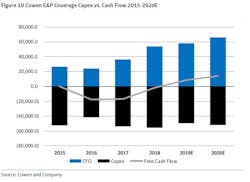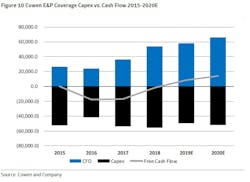Tracking by Cowen Inc., an American multinational investment bank, shows spending plans for 2019 by independent exploration and production firms are down 11%. Cowen expects independent E&Ps to honor capital discipline commitments for the remainder of this year, but if valuation remains depressed the group may pivot back toward growth.
Cowen tracks and analyzes capital spending for 50 pubic independent E&Ps as well as four majors: Chevron Corp., ExxonMobil Corp., BP PLC, and Royal Dutch Shell PLC.
Supermajors’ spending plans for this year are up about 24%. According to Cowen, supermajors likely maintain prior plans regardless of cash flow and continue to target mergers and acquisitions.
Independent E&Ps
Among the independents, Cowen finds budgets to be front-end loaded with 28% of planned 2019 spending completed in the first quarter, and with the second quarter looking flat to higher. Spending in the second half of the year could be down 14% sequentially.
“In prior years when E&Ps outspent during the first half, they would typically boost the budget midyear such that the second half would remain flat or even increase. Midyear budget increases were particularly common when commodity prices were supportive. While [West Texas Intermediate] has improved to $60[/bbl] from $45[/bbl] at the time many budgets were set, we expect commitments to capital discipline will leave plans unchanged, resulting in a second-half decline in spending and activity,” Cowen said.
Capital discipline commitments and higher oil prices will drive an inflection in E&P free cash flow (FCF) during this year’s second half. Cowen expects independent E&Ps to honor capital discipline commitments for the remainder of this year, but if valuation remains depressed, the group may pivot back toward growth.
“With the SPDR S&P Oil & Gas Exploration & Production ETF (XOP) up just 12% year-to-date while WTI is up 37%, the market is not rewarding the stocks. Should this continue, we see a reasonable chance E&Ps pivot back to growth over the next 2-3 quarters heading into 2020,” Cowen said.
Based on the investment bank’s current modeling, which reflects continued discipline, Cowen’s E&P coverage is assumed to grows capex by 3% in 2020 which equates to 77% of cash flow yielding 9% gains in production. However, if E&Ps pivot toward growth, even still spending just 90% of cash flow, capex could rise 30% and oil production 20%.
“While the stocks may not be getting credit for discipline, we suspect a pivot toward growth could be even worse for stock performance,” Cowen said, however.
Majors
Supermajors have refocused attention on developing US unconventional oil, demonstrated by Chevron and ExxonMobil’s multiyear Permian growth strategies and BP’s recent M&A activity.
“We see these companies executing growth plans over the next few years regardless of near-term cash flows. Moreover, following a demonstrated comfort with shale operations, we expect majors to pursue additional M&A, high-grading and expanding their shale footprints as potential valuation dislocation with independents emerge,” Cowen said.
“The supermajors made a late entrance into US shale, in some cases demonstrating patience in delineating acreage (Chevron) and in others using M&A to increase their footprint (BP, ExxonMobil). Now, the group is prioritizing US shale growth over the next 5 years. Specifically, the Permian presents a combination of high returns and relatively low above-ground risks that make it among the most competitive projects in the groups’ project hoppers.”
According to Cowen, the majors have the supplemental FCF and strong balance sheets to absorb negative FCF that accompany ramping up shale production and have plagued many of the independent E&Ps. The group has presented their shale plans with forecasts for turning FCF positive, acknowledging these assets will be FCF negative during development. The companies test their development plans across a range of price scenarios, making it likely the shale activity will be durable even if its positive FCF takes longer to materialize.
Chevron plans to increase Permian production from 400,000 boe/d in fourth-quarter 2018 to 900,000 boe/d at yearend 2023. The company has been rapidly increasing production since 2017 and plans on becoming FCF positive next year.
ExxonMobil will increase their Permian production from 200,000 boe/d in fourth-quarter 2018 to 1 million boe/d by 2024, hitting positive FCF in 2021.
BP expects to increase their transformed Lower 48 footprint from 300,000 boe/d to 500,000 boe/d and generate substantial FCF in 2021.
“In total, we estimate the group will increase shale spend, including on infrastructure, from about $7.5 billion in 2018 to $10 billion in 2019 and about $12 billion in 2020. We assume rig count will increase from 91 in 2019 to 113 in 2019 and 121 in 2020. Altogether we expect this program to result in an additional 162,000 b/d and 172,000 b/d of oil production in 2019 and 2020, respectively,” Cowen said.
Recent M&A activity demonstrates an interest in the group continuing to increase its US shale footprint, particularly in the Permian basin.
“We see the group as a natural consolidator given capacity to absorb near-term net cash outflows for longer-term upside. The potential for the group to consolidate additional shale acreage may suggest a rising floor to shale-related oil field service activity given the ability and desire for the group to spend through the cycle,” Cowen said.

